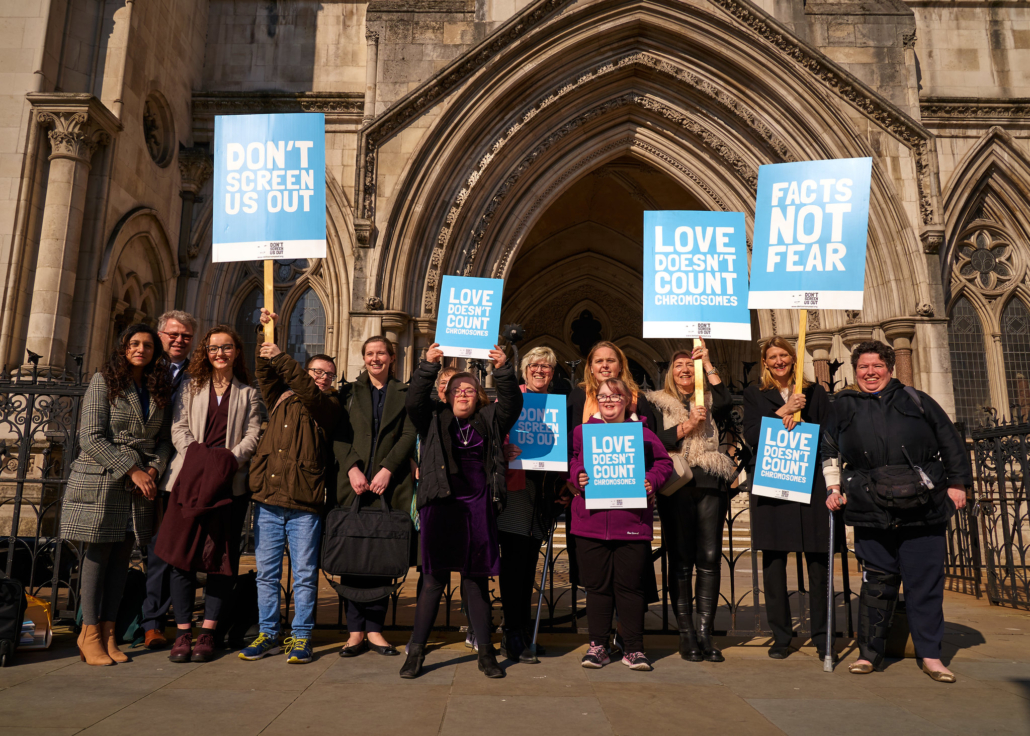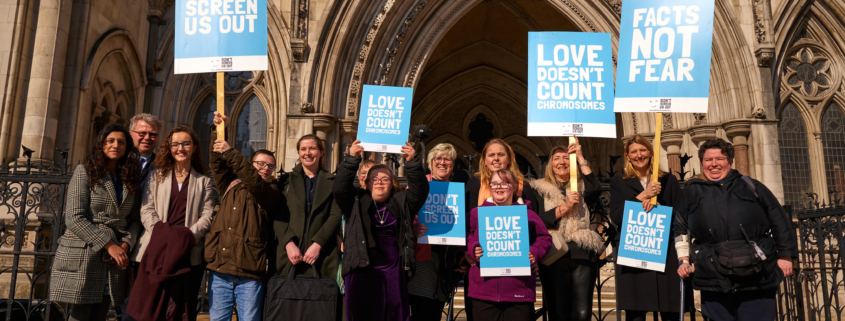Heidi Crowter and the Deathly Laws
On this World Down Syndrome Day, we are going to focus on one of the most important legal battles ever led when it comes to the dignity of persons with Down syndrome.
Heidi Crowter is a woman with Down syndrome who has been fighting for years to remove the section from the UK’s abortion law that allows babies with Down syndrome to be aborted up to birth. Heidi took the UK’s Government to court in 2021, and lost. She appealed to the Court of Appeal in 2022, and lost again. Heidi is now planning to go all the way up to the Supreme Court of the UK.

Background
The Abortion Act 1967 sets the general limit to abortion at 24 weeks of pregnancy. Instances in which abortion is permissible after this limit concern the mother’s grave and permanent injury, risk to her life, and (here comes the eugenic part) “serious handicap” of the baby.
Let’s quote the entire section 1(1)(d) that Heidi seeks to repeal. It says that abortion (no gestational limit included) will not be considered an offense provided “that there is a substantial risk that if the child were born it would suffer from such physical or mental abnormalities as to be seriously handicapped.”
Note this section:
- does not require a diagnosis, it only mentions substantial risks;
- frames disability as suffering;
- operates with ableist terms like abnormalities; and
- uses an extremely vague phrase – what in the world is the objective meaning of seriously handicapped? Seriously.
But all of this seems almost petty in comparison with the Big Issue: Section 1(1)(d) explicitly defines the class of fetuses denied any prenatal legal protection. Unlike all other sections, which concern the situation of the mother, this is the only section in the entire Act that focuses on the child, namely, a specific kind of child.
The UK is not alone in adding this particularly atrocious detail into its abortion legislation. There are at least 16 European countries that explicitly provide for differential limits on the grounds of fetal disability. In total, 31 countries in Europe in some way permit eugenic abortion, but this is often buried under “maternal mental health” or “maternal well-being” phraseology.
The campaign
Heidi and her team have positioned their campaign primarily as a disability campaign for equality, not as a pro-life campaign. In fact, the team has managed to form a broad alliance of both pro-life and pro-choice disability activists. Naturally, though, there were people from within the disability community that worked very hard to present Heidi’s efforts as part of a medieval cunning plan devised by some secretly pro-life Blackadder.
Nevertheless, the discrimination in regards to legal protection is so obvious that those who criticized Heidi’s campaign have often felt obligated to provide an alternative “solution” for achieving equality: abortion up to birth for all fetuses. There’s not much to comment on that – even though it won’t surprise me if this particular brand of fetal equality eventually becomes one of the main arguments for limitless abortion in Europe.
First ruling: The Divisional Court
Heidi’s legal team initially argued that the section 1(1)(d) breaches her human rights, as laid out in the European Convention on Human Rights. Her team focused on the following 4 articles: Article 2 (right to life), Article 3 (freedom from torture), Article 8 (respect for family and private life) and Article 14 (freedom from discrimination).
In 2021, the two judges of the Divisional Court dismissed Heidi’s case in total.
Fun fact: one of the judges, Mrs Justice Lieven, used to represent BPAS (the UK’s largest abortion provider) and became infamous for her rather inglorious decision to legally force a disabled woman to abort her baby against her wishes (thankfully, Lieven’s decision was later overruled by a higher court).
Having lost the case in the Divisional Court, Heidi sought and was granted the right to appeal.
Second ruling: The Appeal Court
But there’s a catch: Heidi’s appeal was granted only on the basis of Article 8 (private life) and Article 14 (discrimination). In other words, right to life and freedom from torture were explicitly denied relevance. This was, of course, predictable, but it actually revealed the true function of Section 1(1)(d).
One might ask: if the Appeal Court preliminarily says that there is no right to life between 24 weeks and birth, why does the state prescribe any limits to abortion at all? Because when the right to life is not granted prenatally, all that is left is the state’s own interest in protecting fetal life. In legal theory, this component constitutes a part of the doctrine called “the margin of appreciation”. In short, when there is no legal recognition of prenatal right to life, this doctrine implies that the state strikes a balance between protecting fetal life (as its own interest, and nobody’s right per se) on the one hand, and protecting private life and autonomy of the mother (as its own interest and the human rights of the mother) on the other. Therefore, denying protection to a class of fetuses means that the state explicitly denies any interest in that class of fetuses.
This gets even more conspicuous if one has in mind that preservation of fetal life actually constitutes legal baseline in the UK: both the Offences Against the Person Act 1861 and the Infant Life (Preservation Act) 1929 make abortion a criminal act, whereas the subsequent Abortion Act 1967 sets the conditions under which abortion is not considered an offense. So, it is not that fetal right to life amounts to zero in the UK, and Section 1(1)(d) divides a zero by a particular group of fetuses – it is more like: “we still uphold the preservation of infant life from 24 weeks of pregnancy (with exceptions concerning the mother’s health situation), but we renounce it completely when it comes to disabled fetuses.”
Explaining their decision to rule against Heidi, the Appeal judges naturally tried to reframe this discrimination of disabled fetuses with arguments designed to shift the focus more towards the situation of the mother, to fit the other sections of the Abortion Act. They justified it by listing potential situations of finding out about the pregnancy later or learning about the baby’s diagnosis later. This is, of course, completely unsound: women may also find out that they are pregnant later in “regular” pregnancies, and may likewise experience very relevant non-medical changes in their circumstances past the 24 weeks limit, but the law does not bend according to these factors – disability is the only relevant difference here.
The invention of the “living disabled”
Left with the task of explaining how the Section 1(1)(d) actually discriminates against Heidi (Article 14) and affects her private life (Article 8), Heidi’s team tried to present evidence of how the section (a) negatively affects the feelings of self-worth and dignity of people with disability and (b) perpetuates and reinforces negative cultural stereotypes about people with disabilities. They presented several impactful personal testimonies, among which were those from Heidi herself, Máire Lea-Wilson – a mum of a boy with Down syndrome who joined Heidi in this lawsuit, and Lord Shinkwin – who has been fighting against this eugenic law for decades in the House of Lords.

Two notable expert opinions were also presented, one by Katrin Scior on the stigma that this law creates, and the other by Richard Hastings regarding his research on the emotional impact of prenatal testing on people with Down syndrome.
But due to the removal of the right to life grounds, and backed up by the general disregard for creating a specific class of prenatal humans in order to deprive that class of standard protection, the causality between the born and the unborn simply evaporated. The judges went out of their way to explain how they accept a substantial negative effect on Heidi’s individual feelings of self-worth and dignity. Nevertheless, they refused to assign any universal relevance to these feelings and concluded that the law in question does not discriminate against “living disabled”. Yes, they even came up with the phrase “living disabled” in order to segregate the born and the unborn, even though the very Abortion Act 1967, as well as the entire legal framework for fetal matters in the UK, use terms like “infant” or “child” for prenatal humans.
Private life: when law forces your mother to reason for your existence
Thanks to Section 1(1)(d), pregnant women are explicitly given a choice to abort a child due to disability only. In practice, this means that medical practitioners are obligated to inform pregnant women about “their options”. This inevitably puts mothers in a position of choosing, and being placed in that position implies the need to justify a reason for their child to live. This, by itself, suffices to constitute discrimination against the “living disabled” in their private and family life: unlike those of the “living non-disabled”, the mothers of the “living disabled” were compelled to reason for giving birth to them. This is the direct effect of the Abortion Act 1967 pertaining to Article 8 of the Convention.
[Read more – Parents talk about being offered abortion for their children with disabilities]
Discriminating potential anyone is actual discrimination
When it comes to Article 14 (discrimination), even if we disregard the fact that UK law does imply protection of prenatal life (and unequally so), the discriminatory effect on the “living disabled” is simply not constituted as the sum of effects experienced after birth. The nature of this effect is collective: it creates a specific legal class of children to be destroyed or born into. The Abortion Act 1967, as it stands, may or may not have an actual effect on a “living disabled,” but it necessarily has an effect on the disabled as such. So, instead of feeling obligated to accept the relevance of Heidi’s feelings while freely dismissing their general relevance, under the proper logic, they would have been obligated to accept the collective relevance of this negative effect, and free to dismiss anyone’s particular feelings. I certainly hope the judges of the Supreme Court will have more capacity for recognizing and understanding these critical nuances.
Final remarks
This strenuous battle is far from over. Heidi and her team will need perseverance, courage and resources to go on. If they win, this will help set up a new era of prenatal equality in Europe and beyond. Please consider supporting Heidi in any capacity you can: from amplifying her voice to donating.
[Part of this post is available in a Twitter thread here.]



